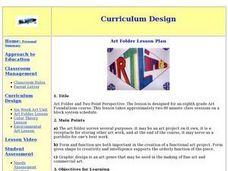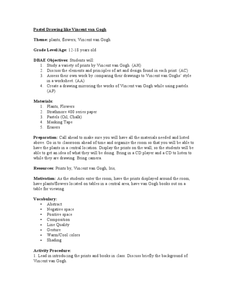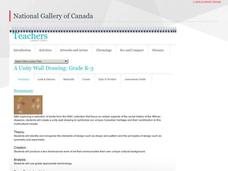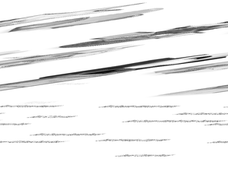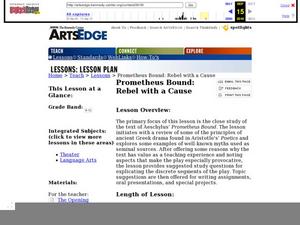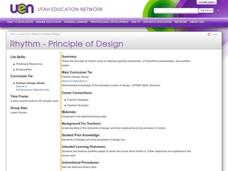Curated OER
Principles of Design
Students study the principles of design by viewing a PowerPoint presentation and then find examples of those principles in magazines. They look through magazines or sketch clothing that exhibit the principles of design and show their...
Curated OER
Principles of Design - Picture Assignment
Students identify, explain and use the basic principles of design. They find a large, clear picture depicting each of the different principles of design and write a complete sentence describing where they see each of the principles of...
Curated OER
Symmetrical Design: Pennsylvania Barn Signs
Second graders explain and apply the visual arts elements and the design principle of symmetry and apply media, techniques, and processes. In addition, they describe how different materials, techniques, and processes cause different...
Curated OER
Give It All You’ve Got Heroes and Visual Art
Sure, your young artists probably know Van Gogh and Picasso, but are they equally as familiar with Frida Kahlo and Andy Warhol? Small groups examine the work of famous artists. Then, they create their own hero portraits in Cubist style...
Curated OER
Art Folder and Two Point Perspective
Eighth graders examine how to create a 3-D effect on a flat surface and draw in two-point perspective. They view and discuss elements of design, analyze artwork by M.C. Escher and Roy Lichtenstein, and design and create an art folder.
Curated OER
Pastel Drawing like Vincent Van Gogh
Learners discuss the elements of art and design found in a series of flower paintings by Vincent Van Gogh. They explore art, shading, and color as they create mirrored representations of the master's art, using oil pastel.
National Gallery of Canada
Panoramic Landscapes
Combine landscape with collage to create unique art pieces. Class members examine works of art before creating their own pieces with photos of a special place. Learners create a panoramic image and add in figures.
National Gallery of Canada
Build a City of the Future!
Tap into your pupils' imagination by asking them to design futuristic, ideal cities. They must discuss and take scale and size into account, looking at some model pieces of art for inspiration and analysis. The final product for each...
Curated OER
Minimal Animals
Have fun creating imaginary creatures with this symmetry lesson plan! Your class will paint one half of their imaginary creature, fold their paper in half, which will result in a symmetrical figure. What a great art project to combine...
Curated OER
Ellis Wilson: A High School Art Lesson
Students study the principles of design and element of the art of Ellis Wilson. They examine how art can create social commentary.
Curated OER
Humourous Head Planter Spike: Ceramics Lesson
What a great activity. Kids create humorous ceramic character (heads) spikes to enliven a planter. Modern art is full of expressive and exaggerated forms and your class gets to create them out of clay. This would be a lovely activity to...
Pace University
Surrealism
Introduce studio artists to the elements and principles of surrealism with a lesson that includes models of the works of famous surrealists. Class members then select a project from a menu and create their own film, poem, or...
Curated OER
The Art of Illustrator Eric Carle
First graders use two-dimensional and three-dimensional media and techniques to communicate ideas, experiences, and stories in works of art. They use media and tools in a safe and responsible manner
National Gallery of Canada
The Body Tells Its Story
Incorporate sculpture into your art curriculum. To start, pupils discuss the artistic process and topics of marginalization. With the discussion in mind, individuals select images to inspire sculptures of people that they will present to...
National Gallery of Canada
One Look Is Worth A Thousand Words
Facial expressions can communicate complex emotions. Examine expressions in several hyperrealistic works of art before beginning a project. Learners will create their own clay faces that show an emotion using either photos or their own...
National Gallery of Canada
Social Realism
Examine social strife in art. Class members first observe some pieces, and then find an image to inspire their own art. They outline the picture, analyze the composition, make alterations, and color their work.
National Gallery of Canada
A Unity Wall Drawing
Build class community with an art project. Learners first examine and discuss works of art. They then contribute to a class mural by tracing their hands and decorating them in relation to their own cultures. The final mural incorporates...
Curated OER
Abstract Planes in Paper Sculpture
High schoolers create maquettes of abstract sculptures utilizing the elements of art; line, shape, value, color, space and texture and the principles of design; balance, emphasis, contrast, rhythm and movement, pattern and unity. These...
Curated OER
Information Problem Solving
Middle schoolers locate the specific elements of text and illustrations that communicate setting, characterization, and plot in order to evaluate how the text and illustrations work together to communicate effectively.
National Gallery of Canada
Tantalizing Tessellations!
Examine repeating and intricate patterns with a study of M.C. Escher and a related art activity. Pupils view and discuss the artwork before creating their own tessellating patterns. Step-by-step instructions for creating a template are...
Curated OER
Prometheus Bound: Rebel with a Cause
If you are teaching Aeschylus' Prometheus Bound, you can't afford to miss this source. An extensive list of ideas outlines numerous discussion topics, writing prompts, comprehension questions, oral presentations, and projects. Have class...
Curated OER
Tony Cragg-Evidence
Students demonstrate an understanding of basic elements and principles of art making such as unity, variety, movement, and meaning found in daily experiences. They also describe the meaning of students¿ own artwork in a written statement.
Curated OER
Communicating Feelings through
Sixth graders use subjects, themes, and symbols to communicate meaning in their own works of art. They describe the origins of specific images and ideas and explain why they are of value in their artwork and in the work of others.
Curated OER
Rhythm - Principle of Design
Students demonstrate knowledge of the principles of design. They produce portfolio pages to show they know what rhythm is and demonstrate the elements of design and their relationship to the principle of rhythm. They explore the world of...






